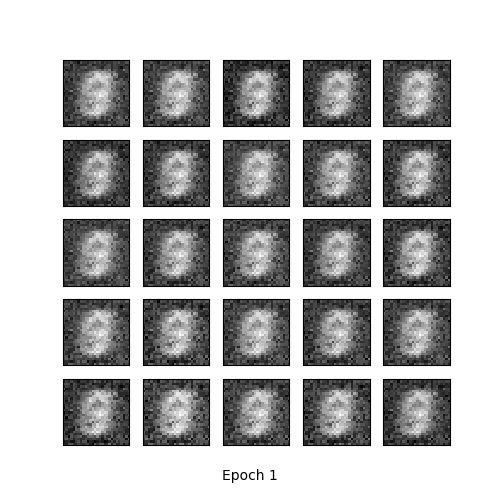GAN,MNIST生成数字
import os import matplotlib.pyplot as plt import itertools import pickle import imageio import torch import torch.nn as nn import torch.nn.functional as F import torch.optim as optim from torchvision import datasets, transforms from torch.autograd import Variable import numpy as np # G(z) class generator(nn.Module): # initializers def __init__(self, input_size=32, n_class = 10): super(generator, self).__init__() self.fc1 = nn.Linear(input_size, 256) self.fc2 = nn.Linear(self.fc1.out_features, 512) self.fc3 = nn.Linear(self.fc2.out_features, 1024) self.fc4 = nn.Linear(self.fc3.out_features, n_class) # forward method def forward(self, input): x = F.leaky_relu(self.fc1(input), 0.2) x = F.leaky_relu(self.fc2(x), 0.2) x = F.leaky_relu(self.fc3(x), 0.2) x = F.tanh(self.fc4(x)) return x class discriminator(nn.Module): # initializers def __init__(self, input_size=32, n_class=10): super(discriminator, self).__init__() self.fc1 = nn.Linear(input_size, 1024) self.fc2 = nn.Linear(self.fc1.out_features, 512) self.fc3 = nn.Linear(self.fc2.out_features, 256) self.fc4 = nn.Linear(self.fc3.out_features, n_class) # forward method def forward(self, input): x = F.leaky_relu(self.fc1(input), 0.2) x = F.dropout(x, 0.3) x = F.leaky_relu(self.fc2(x), 0.2) x = F.dropout(x, 0.3) x = F.leaky_relu(self.fc3(x), 0.2) x = F.dropout(x, 0.3) x = F.sigmoid(self.fc4(x)) return x fixed_z_ = torch.randn((5 * 5, 100)) # fixed noise fixed_z_ = Variable(fixed_z_.cuda(), volatile=True) def show_result(num_epoch, show = False, save = False, path = 'result.png', isFix=False): z_ = torch.randn((5*5, 100)) z_ = Variable(z_.cuda(), volatile=True) G.eval() if isFix: test_images = G(fixed_z_) else: test_images = G(z_) G.train() size_figure_grid = 5 fig, ax = plt.subplots(size_figure_grid, size_figure_grid, figsize=(5, 5)) for i, j in itertools.product(range(size_figure_grid), range(size_figure_grid)): ax[i, j].get_xaxis().set_visible(False) ax[i, j].get_yaxis().set_visible(False) for k in range(5*5): i = k // 5 j = k % 5 ax[i, j].cla() ax[i, j].imshow(test_images[k, :].cpu().data.view(28, 28).numpy(), cmap='gray') label = 'Epoch {0}'.format(num_epoch) fig.text(0.5, 0.04, label, ha='center') plt.savefig(path) if show: plt.show() else: plt.close() def show_train_hist(hist, show = False, save = False, path = 'Train_hist.png'): x = range(len(hist['D_losses'])) y1 = hist['D_losses'] y2 = hist['G_losses'] plt.plot(x, y1, label='D_loss') plt.plot(x, y2, label='G_loss') plt.xlabel('Epoch') plt.ylabel('Loss') plt.legend(loc=4) plt.grid(True) plt.tight_layout() if save: plt.savefig(path) if show: plt.show() else: plt.close() # training parameters batch_size = 128 lr = 0.0002 train_epoch = 100 # data_loader transform = transforms.Compose([ transforms.ToTensor(), #transforms.Normalize(mean=(0.5, 0.5, 0.5), std=(0.5, 0.5, 0.5)) ]) train_loader = torch.utils.data.DataLoader( datasets.MNIST('data', train=True, download=True, transform=transform), batch_size=batch_size, shuffle=True) # network G = generator(input_size=100, n_class=28*28) D = discriminator(input_size=28*28, n_class=1) G.cuda() D.cuda() # Binary Cross Entropy loss BCE_loss = nn.BCELoss() # Adam optimizer G_optimizer = optim.Adam(G.parameters(), lr=lr) D_optimizer = optim.Adam(D.parameters(), lr=lr) # results save folder if not os.path.isdir('MNIST_GAN_results'): os.mkdir('MNIST_GAN_results') if not os.path.isdir('MNIST_GAN_results/Random_results'): os.mkdir('MNIST_GAN_results/Random_results') if not os.path.isdir('MNIST_GAN_results/Fixed_results'): os.mkdir('MNIST_GAN_results/Fixed_results') train_hist = {} train_hist['D_losses'] = [] train_hist['G_losses'] = [] for epoch in range(train_epoch): D_losses = [] G_losses = [] for x_, _ in train_loader: # train discriminator D D.zero_grad() x_ = x_.view(-1, 28 * 28) mini_batch = x_.size()[0] y_real_ = torch.ones(mini_batch) y_fake_ = torch.zeros(mini_batch) x_, y_real_, y_fake_ = Variable(x_.cuda()), Variable(y_real_.cuda()), Variable(y_fake_.cuda()) D_result = D(x_) D_real_loss = BCE_loss(D_result, y_real_) D_real_score = D_result z_ = torch.randn((mini_batch, 100)) z_ = Variable(z_.cuda()) #生成的128张图片 G_result = G(z_) D_result = D(G_result) D_fake_loss = BCE_loss(D_result, y_fake_) D_fake_score = D_result D_train_loss = D_real_loss + D_fake_loss D_train_loss.backward() D_optimizer.step() D_losses.append(D_train_loss.cpu().detach().numpy()) # train generator G G.zero_grad() z_ = torch.randn((mini_batch, 100)) y_ = torch.ones(mini_batch) z_, y_ = Variable(z_.cuda()), Variable(y_.cuda()) G_result = G(z_) D_result = D(G_result) G_train_loss = BCE_loss(D_result, y_) G_train_loss.backward() G_optimizer.step() G_losses.append(G_train_loss.cpu().detach().numpy()) print() print('[%d/%d]: loss_d: %.3f, loss_g: %.3f' % ( (epoch + 1), train_epoch, np.mean(D_losses), np.mean(G_losses))) p = 'MNIST_GAN_results/Random_results/MNIST_GAN_' + str(epoch + 1) + '.png' fixed_p = 'MNIST_GAN_results/Fixed_results/MNIST_GAN_' + str(epoch + 1) + '.png' show_result((epoch+1), save=True, path=p, isFix=False) show_result((epoch+1), save=True, path=fixed_p, isFix=True) train_hist['D_losses'].append(np.mean(D_losses)) train_hist['G_losses'].append(np.mean(G_losses)) print("Training finish!... save training results") torch.save(G.state_dict(), "MNIST_GAN_results/generator_param.pkl") torch.save(D.state_dict(), "MNIST_GAN_results/discriminator_param.pkl") with open('MNIST_GAN_results/train_hist.pkl', 'wb') as f: pickle.dump(train_hist, f) show_train_hist(train_hist, save=True, path='MNIST_GAN_results/MNIST_GAN_train_hist.png') images = [] for e in range(train_epoch): img_name = 'MNIST_GAN_results/Fixed_results/MNIST_GAN_' + str(e + 1) + '.png' images.append(imageio.imread(img_name)) imageio.mimsave('MNIST_GAN_results/generation_animation.gif', images, fps=5)
生成结果

生成器和判别器的loss
